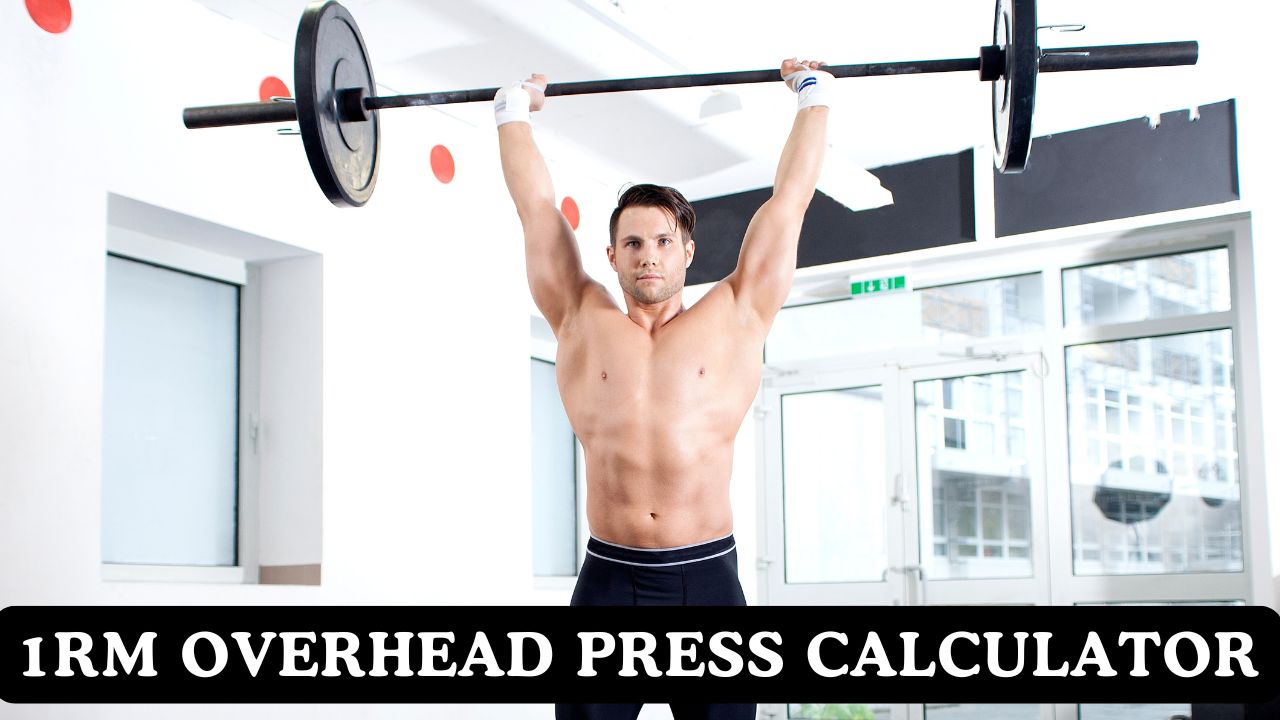Overhead Press 1RM Calculator
Calculate your Overhead Press One Rep Max (1RM) using scientifically validated formulas. Get personalized overhead press training recommendations and percentage-based workout plans optimized for maximum shoulder strength and power development.

Overhead Press One Rep Max (1RM) Training
The Overhead Press One Rep Max (1RM) represents the maximum weight an individual can press overhead for a single repetition with proper form. According to research published in the NSCA Strength and Conditioning Journal, the barbell overhead press is one of the most effective exercises for developing shoulder strength and stability. The movement primarily targets the anterior deltoids, triceps brachii, and requires significant core stabilization throughout the entire kinetic chain.
Biomechanical Analysis
Electromyographic research from Frontiers in Physiology demonstrates that overhead press variations produce different muscle activation patterns. The study shows that back overhead press enhances excitation of medial and posterior deltoids, while front overhead press favors pectoralis major activation. Understanding these biomechanical differences is crucial for optimizing training programs and 1RM development.
Standing vs Seated Variations
Research exploring the standing barbell overhead press reveals that standing variations require greater core stabilization and full-body coordination compared to seated alternatives. Standing overhead press 1RM testing provides a more comprehensive assessment of functional strength, as it incorporates balance, proprioception, and multi-joint coordination under maximum load conditions.
Athletic Performance Correlation
Overhead press 1RM strongly correlates with athletic performance in sports requiring upper body power and shoulder stability. The movement pattern translates directly to throwing mechanics, overhead activities, and functional movements. Elite athletes typically demonstrate overhead press 1RM values ranging from 0.7-1.2 times body weight, depending on sport-specific demands and training specialization.
Overhead Press Variations & 1RM Relationships
| Press Variation | % of Standing Barbell 1RM | Primary Muscles | Difficulty Level | Best For |
|---|---|---|---|---|
| Standing Barbell Press | 100% | Anterior deltoids, triceps, core | High | Maximum strength, stability |
| Seated Barbell Press | 110-115% | Anterior deltoids, triceps | Moderate | Isolated shoulder strength |
| Military Press | 95-100% | Full body integration | Very High | Strict form development |
| Push Press | 120-125% | Power development | Moderate | Explosive strength |
| Standing Dumbbell Press | 85-90% | Unilateral stability | High | Stability, imbalance correction |
| Behind Neck Press | 80-85% | Posterior deltoids | Very High | Advanced practitioners only |
Variation Selection Strategy
Choose overhead press variations based on training goals, mobility limitations, and experience level. Standing barbell press provides the most comprehensive strength assessment, while seated variations allow for heavier loading with reduced stability demands. Push press enables supramaximal loading for strength development, but should not be confused with strict pressing strength. Behind neck pressing requires exceptional shoulder mobility and should only be attempted by experienced lifters.
Overhead Press 1RM Strength Standards
Male Overhead Press 1RM Standards (kg)
| Body Weight | Beginner | Novice | Intermediate | Advanced | Elite |
|---|---|---|---|---|---|
| 60kg | 25kg | 40kg | 55kg | 70kg | 85kg |
| 70kg | 30kg | 45kg | 65kg | 80kg | 95kg |
| 80kg | 35kg | 55kg | 75kg | 90kg | 110kg |
| 90kg | 40kg | 60kg | 80kg | 100kg | 120kg |
| 100kg | 45kg | 65kg | 85kg | 110kg | 130kg |
Female Overhead Press 1RM Standards (kg)
| Body Weight | Beginner | Novice | Intermediate | Advanced | Elite |
|---|---|---|---|---|---|
| 50kg | 15kg | 25kg | 35kg | 45kg | 55kg |
| 60kg | 20kg | 30kg | 40kg | 50kg | 65kg |
| 70kg | 25kg | 35kg | 45kg | 60kg | 75kg |
| 80kg | 30kg | 40kg | 55kg | 70kg | 85kg |
| 90kg | 35kg | 45kg | 60kg | 75kg | 90kg |
Standards Interpretation
These overhead press 1RM standards are based on extensive strength data from recreational to competitive lifters, assuming proper standing barbell press technique. Standards consider factors including training experience, body composition, and limb proportions. Individual variations exist based on shoulder mobility, training history, and genetic factors. Use these standards as general guidelines for setting realistic strength goals and tracking progress over time.
Overhead Press 1RM Periodization Model
| Training Phase | Duration | Intensity (%1RM) | Volume (Reps) | Sets | Rest Period | Primary Adaptation |
|---|---|---|---|---|---|---|
| Anatomical Adaptation | 4-6 weeks | 50-70% | 12-20 | 2-3 | 1-2 min | Technique, endurance |
| Hypertrophy | 4-6 weeks | 65-80% | 6-12 | 3-4 | 2-3 min | Muscle growth |
| Maximum Strength | 4-6 weeks | 80-95% | 1-6 | 4-6 | 3-5 min | Neural adaptation |
| Power | 3-4 weeks | 30-60% | 3-6 | 3-5 | 3-5 min | Rate of force development |
| Peaking | 2-3 weeks | 85-100% | 1-3 | 3-5 | 3-5 min | Competition preparation |
| Recovery | 1-2 weeks | 40-60% | 8-15 | 2-3 | 1-2 min | Active recovery |
Periodization Benefits for Overhead Press
Systematic periodization of overhead press training produces superior strength gains compared to non-periodized approaches. The overhead press responds particularly well to undulating periodization models that vary intensity and volume to prevent plateaus and optimize neural adaptations. Proper periodization also reduces injury risk by managing training stress and allowing for adequate recovery between high-intensity sessions.
Advanced Overhead Press Training Techniques
Pin Press Variations
Protocol: Press from various pin heights in power rack
Benefits: Overcome sticking points, build lockout strength
Pin presses eliminate the stretch-shortening cycle and target specific ranges of motion. Set pins at forehead level, nose level, or chin level
to address individual weaknesses. Use 100-110% of full ROM 1RM for pin press training.
Tempo Overhead Press
Method: Controlled eccentric phase (3-5 seconds down)
Benefits: Increased time under tension, improved control
Tempo pressing enhances strength in the lengthened position and improves eccentric strength. Use 70-85% of 1RM
with various tempo prescriptions (e.g., 4-1-1-1 or 5-2-X-1) to develop different strength qualities.
Push Press Integration
Setup: Use leg drive to assist pressing motion
Benefits: Supramaximal loading, power development
Push press allows handling 120-130% of strict press 1RM, providing supramaximal stimulus for strength adaptation.
Focus on minimal leg drive and maximal pressing effort to maintain carryover to strict pressing strength.
Frequently Asked Questions
How often should I test my overhead press 1RM?
Beginners: Every 8-12 weeks during strength phases
Intermediate: Every 6-8 weeks or at mesocycle transitions
Advanced: Every 4-6 weeks during peaking phases
Powerlifters: 2-4 weeks before competition
Avoid frequent 1RM testing as overhead pressing is particularly demanding on the shoulder joint and central nervous system.
What’s the proper overhead press 1RM testing protocol?
Warm-up Protocol:
1. General warm-up: 10-15 minutes dynamic movement
2. Shoulder mobility and activation work
3. Empty barbell × 10 reps
4. 50% 1RM × 8 reps
5. 70% 1RM × 5 reps
6. 85% 1RM × 3 reps
7. 95% 1RM × 1 rep
8. 100%+ 1RM attempts
Rest 3-5 minutes between heavy sets, ensure proper safety setup with spotters or safety bars.
What are common overhead press 1RM testing mistakes?
Avoid These Errors:
• Insufficient shoulder warm-up and mobility work
• Excessive back arch or leg drive (unless testing push press)
• Testing when shoulders are fatigued from previous training
• Attempting 1RM without mastering proper pressing technique
• Ignoring individual shoulder mobility limitations
• Testing too frequently (more than every 4-6 weeks)
• Poor bar path and pressing mechanics under maximum load
How does overhead press 1RM relate to other lifts?
Typical Strength Ratios:
• Bench Press: 140-160% of overhead press 1RM
• Squat: 250-300% of overhead press 1RM
• Deadlift: 280-350% of overhead press 1RM
• Body Weight: 0.7-1.2x for males, 0.5-0.9x for females
These ratios vary based on training specialization, body proportions, and individual strengths. Use as general guidelines
for balanced strength development and identifying potential weaknesses.
What safety equipment is essential for overhead press 1RM testing?
Essential Safety Equipment:
• Power rack or squat rack with adjustable safety bars
• Olympic barbell with secure collars
• Experienced spotters familiar with overhead press safety
• Proper footwear with stable, flat soles
• Optional: lifting belt for core support, wrist wraps
Never attempt maximum overhead presses without proper safety measures and spotting protocols in place.
Overhead Press Safety & Injury Prevention
Pre-Press Mobility Requirements
Essential Mobility Areas:
• Shoulder flexion: 180+ degrees overhead reach
• Thoracic spine extension: Maintain neutral position under load
• Ankle dorsiflexion: Stable base for standing variations
• Hip flexor flexibility: Prevent excessive lumbar extension
Address mobility limitations before attempting heavy overhead pressing. Poor mobility leads to compensations and increased injury risk.
Common Overhead Press Injuries & Prevention
Injury Prevention Strategies:
• Shoulder impingement: Proper bar path, adequate warm-up
• Lower back strain: Core stability, avoid excessive arch
• Neck strain: Neutral head position, proper setup
• Elbow issues: Proper grip width, controlled tempo
Most overhead press injuries result from poor technique, inadequate mobility, or progressing too rapidly in load.
Post-Press Recovery Protocol
Recovery Strategies:
• Immediate: Shoulder decompression, light stretching
• 24 hours: Ice if inflamed, gentle mobility work
• 48 hours: Assess shoulder function, monitor soreness
• Return to training: Gradual load progression, technique focus
Heavy overhead pressing sessions require 48-72 hours recovery for optimal adaptation and injury prevention.
Related
- Barbell Racking Calculator
- Push-Up Weight Calculator
- Wilks Calculator
- DOTS Calculator
- One-Rep (1RM) Max Calculator
- One-Rep Max (1RM) Bench Press Calculator
References
- Coratella, G., Tornatore, G., Longo, S., Esposito, F., & Cè, E. (2022). Front vs Back and Barbell vs Machine Overhead Press: An Electromyographic Analysis and Implications For Resistance Training. Frontiers in Physiology, 13, 825880.
- Graham, John MS, CSCS*D, FNSCA. Barbell Overhead Press. Strength and Conditioning Journal 30(6):p 70-71, December 2008. |
- Kroell, Jordan & Mike, Jonathan. (2017). Exploring the Standing Barbell Overhead Press. Strength and Conditioning Journal. 39. 1.
- Knutzen, Kathleen; Brilla, Lorraine; Caine, Dennis (August 1999). “Validity of 1RM Prediction Equations for Older Adults”. The Journal of Strength & Conditioning Research. 13 (3): Vol 13, Issue 3, Page 242–246. Retrieved 11 July 2014.
- Epley, Boyd (1985). “Poundage Chart”. Boyd Epley Workout. Lincoln, NE: Body Enterprises. p. 86.
- Brzycki, Matt (1998). A Practical Approach To Strength Training. McGraw-Hill.
- Kemmler, Wolfgang K.; Lauber, Dirk; Wassermann, Alfred; Mayhew, Jerry L. (2006-11-01). “Predicting maximal strength in trained postmenopausal woman”. Journal of Strength and Conditioning Research. 20 (4): 838–842.
- Naclerio Ayllón, Fernando; Jiménez Gutiérrez, Alfonso; Alvar, Brent A.; Peterson, Mark D. (2009). “Assessing strength and power in resistance training”. Journal of Human Sport and Exercise. 4 (2): 100–113.

Manish is a NASM-certified fitness and nutrition coach with over 10 years of experience in weight lifting and fat loss fitness coaching. He specializes in gym-based training and has a lot of knowledge about exercise, lifting technique, biomechanics, and more.
Through “Fit Life Regime,” he generously shares the insights he’s gained over a decade in the field. His goal is to equip others with the knowledge to start their own fitness journey.
